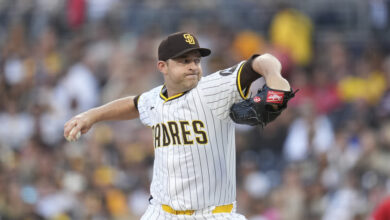
Michael Busch Going Through Highs, Lows of Adjusting at Plate
With their two most dangerous hitters still on the shelf indefinitely, the Cubs really need someone to step up and carry the load offensively. Christopher Morel was able to shake off his funk to provide a late spark Monday night, but Michael Busch was 0-for-4 with a pair of strikeouts and could use another big game. Though he’s had three multihit games out of 11 since his home run binge, he’s gone hitless in seven of those contests and hasn’t left the yard once.
Not only has the power been absent — he has just one double — his plate discipline is all out of whack with a 41.3% strikeout rate and 4.3% walk rate. It’s like a discount version of Patrick Wisdom right now, even if we’re only talking about two weeks. If things are going to turn around, and they certainly can in a hurry, Busch is going to need to adjust his approach and how he handles breaking balls.
The curve has been a particularly tough pitch for him to hit, as evidenced by a .111 average with an anemic .090 wOBA that not even Popeye levels of spinach could cure. This isn’t a matter of bad luck either, at least not according to what Statcast says is a .112 expected batting average. As for other offerings, Busch has a .575 wOBA against cutters, .481 against sliders, .380 against changeups, .360 against sinkers, and .318 against four-seams.
A lot of that came in the early going, when he was seeing more hard stuff as pitchers worked to beat him in the zone and probe his weaknesses a bit. The heat maps below show the locations of breaking balls Busch has seen so far this season, with the top displaying results through the end of that homer streak on April 15 and the bottom displaying everything after. Notice how the frequency has moved down toward both corners.
He’s also seeing significantly more of them overall and in two-strike counts, with the percentage in the latter situations jumping from 31.5% in the early going to 37.3% since all those homers.


Now let’s look at how pitchers have changed the way they attack Busch with hard stuff, again using the same date ranges. The more recent image shows clearly that the focus has been in the upper-middle third of the zone and above with far less distribution to other areas.


Finally, we’ll take a look at the first baseman’s swing percentage by location to get an idea of how he’s responded to the shift in strategy. What jumps out immediately is how many more pitches he’s swinging at outside the zone, which is a direct response to how and where he’s being pitched. He’s been making contact with those pitches at about the same rate, but the problem is that the increased frequency of his swings means a lower overall quality of contact.


So what’s the solution? Simple: Stop swinging at pitches out of the zone. Except it’s not so simple because the same thing is true for just about every hitter in history not named Vladimir Guerrero. The reality is that there’s no magic bullet and Busch may have to work on a few different things mechanically and mentally in order to course correct. Or perhaps it’s just a matter of being more patient.
The opposite was true for Seiya Suzuki, who was letting too many good pitches go by early in counts as he sought the perfect pitch. Getting more aggressive allowed him to do damage while avoiding umpires’ inconsistent and often unfair judgment. Busch, on the other hand, might benefit from letting some of those close ones go in 0-0 counts or with less than two strikes.
He’s technically getting more first-pitch strikes and pitches in the zone on the whole, though this more recent sample is only about two-thirds of the earlier one and things could shift quickly in just a game or two. We could talk about sitting on spin and adjusting to heat or looking low in the zone and battling on pitches up, but that’s easier said than done. The key is that he’s got to find something he can work on without being in his head at the plate.
It would also help to play the matchups, something Craig Counsell did when the Marlins threw three lefties at the Cubs. Busch is batting .167 with a 20 wRC+ against southpaws, a far sight worse than his .284 and 149 against righties. That’s where Garrett Cooper may have helped, though Wisdom will certainly suffice.
Getting Suzuki and Cody Bellinger back in the lineup should yield an improvement as well, though the idea of protection is probably more than a little bit overblown. If anything, the real benefit comes from the rookie being able to get more comfortable knowing he doesn’t need to do the heavy lifting. After all, it’s much easier to bring the gravy to dinner than to cook the turkey.
Now we just have to sit back and watch as Busch destroys Mets pitching over the next few days to make me look like a fool.

